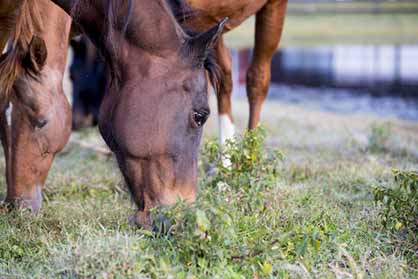So Much Acid: Common Feeding Practices Could Cause Your Horse’s Stomach Acid to Rise
Common feeding practices could be causing your horse’s stomach acid levels to rise.
Did you know the average horse’s stomach only has a 2- to 4-gallon capacity?1 That’s because it was designed to digest a small but steady stream of forage throughout the day.1 Horses evolved as grazers, spending two-thirds of the day grazing.1 As they continuously graze, they produce a large amount of saliva and maintain a mixture of roughage and saliva in their stomach most, if not all, of the time to buffer and help pass acid from the stomach. However, the feeding styles of today’s performance horses don’t typically follow that schedule.
When horses are fed meals, especially concentrates containing cereal grains that are passed through the stomach more quickly than roughage, there are likely to be times during the day or overnight when the stomach is empty of feed material but is still producing strong gastric acid. In fact, horses produce up to 16 gallons of acidic gastric juice each day.2
That’s equivalent to:
– The gas tank of an average car
– Three 5-gallon water buckets
– Half of an average bathtub
The stomach’s lower part is lined by glandular mucosa and is where the acid is produced. That’s where the acid is meant to reside and digest food. The glandular mucosa has a thick mucous layer, robust blood flow and naturally-produced sodium bicarbonate, all of which protect the lower portion of the stomach from the acid. The upper part of the stomach, lined by squamous mucosa, doesn’t have the same protection from the acid. If the stomach doesn’t have any food in it, the acidic juice accumulates and reaches the unprotected upper part of the stomach, burning the squamous lining and causing stomach ulcers.
“Horse owners have to consider the sheer amount of acid the horse’s stomach produces, and that acid is being produced whether there is food in the stomach or not,” says Hoyt Cheramie, DVM, MS, DACVS, Senior Equine Professional Service Veterinarian, Boehringer Ingelheim. “The most natural way to feed a horse is to provide grazing for most of the day. However, that isn’t feasible for most performance horses that are fed large infrequent meals, have limited turnout and grazing, and are under the stress of training, showing and traveling; yet their stomachs still produce all of that gastric fluid on relatively empty stomachs.”
The most natural way to decrease the strength of the acidic juice in the stomach and to keep it off the upper squamous lining is to take advantage of a quality roughage based diet, and Cheramie suggests:
– Increasing grazing time whenever possible
– Using a slow-feed or grazing hay net
– Replacing calories from cereal grains with good quality roughage
– Adding alfalfa to the diet where appropriate
– A higher-roughage diet results in a lower acid level due to the buffering effect of the roughage and saliva.3
Ulcer Prevention and Treatment
When acid levels rise and cause stomach ulcers, the pain can cause your horse not to perform at their best.
The active ingredient in ULCERGARD® (omeprazole) and GASTROGARD® (omeprazole) inhibits acid production at the source – the proton pumps in the glandular mucosa.4,5 Only ULCERGARD and GASTROGARD have a patented formulation that protects the omeprazole from being broken down by acid. This ensures that the omeprazole makes it through the acid of the stomach into the intestines where it is absorbed into the bloodstream and then makes its way back to the stomach to work effectively.
As a result of the way performance horses are commonly fed, and in addition to the stress of training, showing and traveling, stomach or gastric ulcers are more common than you might think, with two out of three competitive horses affected.5,6 Help protect against ulcers during times of stress with the proven power of FDA-approved ULCERGARD.5 When ulcers are present, treat with GASTROGARD, the only FDA-approved equine gastric ulcer treatment.4
Feeding a performance horse isn’t without challenges. Ask your veterinarian or equine nutritionist for feeding recommendations to help keep acid levels under control.
IMPORTANT SAFETY INFORMATION:
ULCERGARD can be used in horses that weigh at least 600 pounds. Safety in pregnant mares has not been determined.
Caution: Safety of GASTROGARD in pregnant or lactating mares has not been determined.
About Boehringer Ingelheim Animal Health
On January 1st, 2017, Merial became part of the Boehringer Ingelheim group. As the second largest animal health business in the world, Boehringer Ingelheim is committed to making the industry even better at improving animal health. With more than 10,000 employees worldwide, Boehringer Ingelheim Animal Health has products available in more than 150 markets and a global presence in 99 countries. For more information about Boehringer Ingelheim Animal Health, click here.
About Boehringer Ingelheim
Boehringer Ingelheim is one of the world’s 20 leading pharmaceutical companies. Headquartered in Ingelheim, Germany, Boehringer Ingelheim operates presently with a total of some 50,000 employees worldwide. The focus of the family-owned company, founded in 1885, is on researching, developing, manufacturing and marketing new medications of high therapeutic value for human and veterinary medicine. In 2015, Boehringer Ingelheim achieved net sales of about 14.8 billion euros. R&D expenditure corresponds to 20.3 per cent of net sales. For more information, please visit www.boehringer-ingelheim.com.
Merial is now part of Boehringer Ingelheim.
®GASTROGARD and ULCERGARD are registered trademarks of Merial. ©2017 Merial, Inc., Duluth, GA. All rights reserved. EQUIUGD1709 (7/17)
1Williams C. The Basics of Equine Nutrition. Available at: http://esc.rutgers.edu/fact_sheet/the-basics-of-equine-nutrition/. Accessed April 3, 2017.
2Kitchen DL, Merritt AM, Burrow JA. Histamine-induced gastric acid secretion in horses. Am J Vet Res. 1998;59(10):1303-1306.
3Murray MJ. Overview of equine gastroduodenal ulceration. AAEP Proceedings. 1997;43:382-387.
4GASTROGARD product label.
5ULCERGARD product label.
6Mitchell RD. Prevalence of gastric ulcers in hunter/jumper and dressage horses evaluated for poor performance. Association for Equine Sports Medicine, September 2001.











